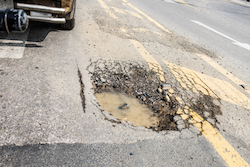Making road traffic greener by boosting car-sharing and improving road quality
Passenger cars account for 73.7 % of total intra-EU passenger transport, with an average car occupancy rate well below 2 passengers per car so there is clearly some benefit to finding a way to encourage the uptake of car-sharing. Online communities exist to boost the uptake of car sharing, but while that deals with one aspect of unnecessary emissions, the bad quality of some road surfaces is also a cause of pollution. Delayed maintenance impairs road safety and increases the cost of driver-intervention, vehicle operating costs, and emissions. Prof Alessandro Bogliolo from the University of Urbino in Italy, who is coordinating the EU-funded CROWDS4ROADS project, explains that the smoother the road surface the lower the emissions. Greater together CROWDS4ROADS is bringing together an online community and a crowd-sensing system to maximise the impact of each. BlaBlaCar is the one of the largest ride-sharing community worldwide, with more than 10 million members in 14 countries, while SmartRoadSense is a crowd sensing system that makes use of the accelerometers of car-mounted smartphones to estimate the roughness of the road surface. The project goes beyond data gathering and transmission; it is working to increase passenger awareness by involving them in the data collection process. The team believes by engaging drivers and passengers in monitoring roads and encouraging them to car-pool, they can have a big impact on maintenance strategies and on environmental footprints in terms of car occupancy rate, road monitoring, and end-user engagement in road maintenance and transport sustainability. How the tools work A paper published by the CROWDS4ROADS project, ‘A Study on the Influence of Speed on Road Roughness Sensing: The SmartRoadSense Case’ explains that approaches for monitoring road surface conditions involve the adoption of costly and sophisticated hardware equipment. Laser profilers, or specific accelerometers with data acquisition systems are some tools whose cost, for each car (also taking into account calibration and installation), can be significant. But the phones many of us carry can provide useful data at no extra cost when it comes to collection and sharing. Once the user downloads the app, SmartRoadSense works through the sophisticated technology embedded in our smart phones: accelerometer data is used to detect braking events and bumps on roads using machine learning techniques and gyroscopes are used to detect road surface anomalies. The roughness index and the smartphone GPS data are periodically sent to a central server where they are processed, associated with the specific road, and aggregated with data measured by other smartphones. This data can then be used by local authorities to identify where their roads need repair, which, in turn makes the cars that use them more energy efficient. BlaBlaCar offers users cheap rides in shared cars. Using a rating system and verified member profiles the network sets out an alternative to driving long distances alone. The CROWDS4ROADS project has targeted Italy, Romania, UK, and Greece and has run a local-scale pilot in Ancona and larger pilots have been set up in Regione Marche and Italy, while replication pilots are in place in Italy, Romania, and the UK. An open data set with more than 2 000 000 records, automatically updated every 6 hours with crowd-sensed data, has been published. For more information: CROWD4ROADS website SmartRoadSense video SmartRoadApp
Countries
Italy



